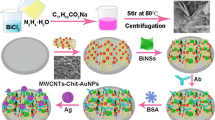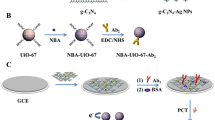Abstract
An impedimetric immunosensor based on gold-silver core-shell nanoparticles for hepcidin detection is reported. The core-shell nanoparticles were prepared by seed-mediated method and characterized by dynamic light scattering, UV-Vis, XRD, field emission-scanning electron micrograph imaging, energy dispersive spectroscopy, and atomic force microscopy. The immunosensor was fabricated with core-shell nanoparticles and cysteamine employing covalent chemistry (amide bond formation) strategy for ensuring proper orientation of anti-hepcidin antibody on to the amine-functionalized nanomaterial decorated electrodes. The hepcidin detection principle was based on the variation of charge transfer resistance (ΔRct) relative to the Fe(CN)64−/3− electrochemical probe in the presence of the biomarker. The frequency range was 10−1 to 105 Hz at the scan rate of 10 mV s−1and a potential of 0.1 V. Based on the antigen-antibody interaction in 40 min at pH 7.0, a linear relationship between ΔRct and hepcidin concentration was obtained in the range 0.01 to 100 ng/mL with a detection limit of 0.857 pg/mL. Furthermore, the designed immunosensor had acceptable reproducibility, stability, selectivity, and reusability. It was successfully applied to the detection of hepcidin in spiked human serum samples and acceptable recovery (90–95.9%) was obtained.

Gold-silver core-shell nanoparticle–based impedimetric immunosensor for detection of iron homeostasis biomarker hepcidin. The study focuses on the detection of iron regulatory protein hepcidin using gold-silver core-shell nanoparticles. This immunosensor was fabricated with core-shell nanoparticles and cysteamine employing covalent chemistry (amide bond formation) strategy. The sensor was sensitive in the range from 0.01 to 100 ng/mL, with a detection limit of 0.857 pg/mL.






Similar content being viewed by others
References
Hare DJ (2017) Hepcidin: a real-time biomarker of iron need. Metallomics 9:606–618
Cox HD, Miller GD, Lai A, Cushman D, Ganz T, Eichner D (2018) Evaluation of serum markers for improved detection of autologous blood transfusions. Haematologica 103:e443–e445
Leuenberger N, Bulla E, Salamin O, Nicoli R, Robinson N, Baume N, Saugy M (2017) Hepcidin as a potential biomarker for blood doping. Drug Test Anal 9:1093–1097
Enko D, Zelzer S, Fauler G, Herrmann M (2019) Evaluation of a commercial liquid-chromatography high-resolution mass-spectrometry method for the determination of hepcidin-25. Biochem Med (Zagreb) 29:020701
Moghieb A, Tesfay L, Nie S, Gritsenko M, Fillmore TL, Jacobs JM, Smith RD, Torti FM, Torti SV, Shi T, Ansong C (2019) A targeted mass spectrometric assay for reliable sensitive hepcidin quantification. Sci Rep 9:7264
Abbas IM, Hoffmann H, Montes-Bayon M, Weller MG (2018) Improved LC-MS/MS method for the quantification of hepcidin-25 in clinical samples. Anal Bioanal Chem 410:3835–3846
Schmitz EMH, Leijten NM, van Dongen JLJ, Broeren MAC, Milroy LG, Brunsveld L, Scharnhorst V, van de Kerkhof D (2018) Optimizing charge state distribution is a prerequisite for accurate protein biomarker quantification with LC-MS/MS, as illustrated by hepcidin measurement. Clin Chem Lab Med 56:1490–1497
Vialaret J, Picas A, Delaby C, Bros P, Lehmann S, Hirtz C (2018) Nano-flow vs standard-flow: which is the more suitable LC/MS method for quantifying hepcidin-25 in human serum in routine clinical settings? J Chromatogr B Anal Technol Biomed Life Sci 1086:110–117
Delaby C, Bros P, Vialaret J, Moulinier A, Delatour V, Gabelle A, Lehmann S, Hirtz C (2017) Quantification of hepcidin-25 in human cerebrospinal fluid using LC-MS/MS. Bioanalysis 9:337–347
Cenci L, Andreetto E, Vestri A, Bovi M, Barozzi M, Iacob E, Busato M, Castagna A, Girelli D, Bossi AM (2015) Surface plasmon resonance based on molecularly imprinted nanoparticles for the picomolar detection of the iron regulating hormone Hepcidin-25. J Nanobiotechnology 13:51
Scarano S, Vestri A, Ermini ML, Minunni M (2013) SPR detection of human hepcidin-25: a critical approach by immuno- and biomimetic-based biosensing. Biosens Bioelectron 40:135–140
Nicole US, Christophe Z, Eloïse F, Dorine WS, Michael BZ, Diego M (2017) Prediction of human iron bioavailability using rapid c-ELISAs for human plasma hepcidin. Clin Chem Lab Med 55:1186–1192
Grebenchtchikov N, Geurts-Moespot AJ, Kroot JJC, Den Heijer M, Tjalsma H, Swinkels DW, Sweep FGJ (2009) High-sensitive radioimmunoassay for human serum hepcidin. Br J Haematol 146:317–325
Bell L, Calder B, Hiller R, Klein A, Soares NC, Stoychev SH, Vorster BC, Tabb DL (2018) Challenges and opportunities for biological mass spectrometry core facilities in the developing world. J Biomol Tech 29:4–15
Felix FS, Angnes L (2018) Electrochemical immunosensors - a powerful tool for analytical applications. Biosens Bioelectron 102:470–478
Wongkaew N, Simsek M, Griesche C, Baeumner AJ (2019) Functional nanomaterials and nanostructures enhancing electrochemical biosensors and lab-on-a-chip performances: recent progress, applications, and future perspective. Chem Rev 119:120–194
Siangproh W, Dungchai W, Rattanarat P, Chailapakul O (2011) Nanoparticle-based electrochemical detection in conventional and miniaturized systems and their bioanalytical applications: a review. Anal Chim Acta 690:10–25
Tang J, Tang D (2015) Non-enzymatic electrochemical immunoassay using noble metal nanoparticles: a review. Microchim Acta 182:2077–2089
Steinbruck A, Stranik O, Csaki A, Fritzsche W (2011) Sensoric potential of gold-silver core-shell nanoparticles. Anal Bioanal Chem 401:1241–1249
Chu X, Fu X, Chen K, Shen G-L, Yu R-Q (2005) An electrochemical stripping metalloimmunoassay based on silver-enhanced gold nanoparticle label. Biosens Bioelectron 20:1805–1812
Chumbimuni-Torres KY, Dai Z, Rubinova N, Xiang Y, Pretsch E, Wang J, Bakker E (2006) Potentiometric biosensing of proteins with ultrasensitive ion-selective microelectrodes and nanoparticle labels. J Am Chem Soc 128:13676–13677
Min IH, Choi L, Ahn KS, Kim BK, Lee BY, Kim KS, Choi HN, Lee WY (2010) Electrochemical determination of carbohydrate-binding proteins using carbohydrate-stabilized gold nanoparticles and silver enhancement. Biosens Bioelectron 26:1326–1331
Gan T, Li J, Xu L, Guo S, Zhao A, Sun J (2020) Multishell au@Ag@SiO2 nanorods embedded into a molecularly imprinted polymer as electrochemical sensing platform for quantification of theobromine. Microchim Acta 187:291
Lv H, Zhang X, Li Y, Ren Y, Zhang C, Wang P, Xu Z, Li X, Chen Z, Dong Y (2019) An electrochemical sandwich immunosensor for cardiac troponin I by using nitrogen/sulfur co-doped graphene oxide modified with Au@Ag nanocubes as amplifiers. Microchim Acta 186:416
Mujawar MA, Gohel H, Bhardwaj SK, Srinivasan S, Hickman N, Kaushik A (2020) Nano-enabled biosensing systems for intelligent healthcare: towards COVID-19 management. Mater Today Chem 17:100306
Kaushik A (2019) Biomedical Nanotechnology Related Grand Challenges and Perspectives. Front. Nanotechnol 1: 2673-3013
Kimling J, Maier M, Okenve B, Kotaidis V, Ballot H, Plech A (2006) Turkevich method for gold nanoparticle synthesis revisited. J Phys Chem B 110:15700–15707
Chen S, Liu L, Zhou J, Jiang S (2003) Controlling antibody orientation on charged self-assembled monolayers. Langmuir 19:2859–2864
Dixit CK, Vashist SK, MacCraith BD, O’Kennedy R (2011) Multisubstrate-compatible ELISA procedures for rapid and high-sensitivity immunoassays. Nat Protoc 6:439–445
Zhang Y, Zhang Z, Rong S, Yu H, Gao H, Ding P, Chang D, Pan H (2020) Electrochemical immunoassay for the carcinoembryonic antigen based on Au NPs modified zeolitic imidazolate framework and ordered mesoporous carbon. Mikrochim Acta 187:264
Cho I-H, Kim DH, Park S (2020) Electrochemical biosensors: perspective on functional nanomaterials for on-site analysis. Biomater Res 24:6
Raghav R, Srivastava S (2015) Core–shell gold–silver nanoparticles based impedimetric immunosensor for cancer antigen CA125. Sensors Actuators B Chem 220:557–564
Krejcova L, Novotny F, Pumera M (2019) Observed dramatically improved catalysis of Ag shell on Au/Ag core-shell nanorods is due to silver impurities released during etching process. Electroanalysis 31:1873–1877
Yang X, Wang Y, Liu Y, Jiang X (2013) A sensitive hydrogen peroxide and glucose biosensor based on gold/silver core–shell nanorods. Electrochim Acta 108:39–44
Huang J-Y, Lin H-T, Chen T-H, Chen C-A, Chang H-T, Chen C-F (2018) Signal amplified gold nanoparticles for cancer diagnosis on paper-based analytical devices. ACS Sens 3:174–182
Annur D, Wang Z-K, Liao J-D, Kuo C (2015) Plasma-synthesized silver nanoparticles on electrospun chitosan nanofiber surfaces for antibacterial applications. Biomacromolecules 16:3248–3255
Pande S, Ghosh SK, Praharaj S, Panigrahi S, Basu S, Jana S, Pal A, Tsukuda T, Pal T (2007) Synthesis of normal and inverted gold−silver core−shell architectures in β-cyclodextrin and their applications in SERS. J Phys Chem C 111:10806–10813
Pei L, Huang Y, Li C, Zhang Y, Rasco B, Lai K (2014) Detection of triphenylmethane drugs in fish muscle by surface-enhanced raman spectroscopy coupled with Au-Ag core-shell nanoparticles. J Nanomater 2014: 1-8
Banerjee M, Sharma S, Chattopadhyay A, Ghosh S (2011) Enhanced antibacterial activity of bimetallic gold-silver core-shell nanoparticles at low silver concentration. Nanoscale 3:5120–5125
Roushani M, Valipour A, Valipour M (2016) Layer-by-layer assembly of gold nanoparticles and cysteamine on gold electrode for immunosensing of human chorionic gonadotropin at picogram levels. Mater Sci Eng C 61:344–350
Love JC, Estroff LA, Kriebel JK, Nuzzo RG, Whitesides GM (2005) Self-assembled monolayers of thiolates on metals as a form of nanotechnology. Chem Rev 105:1103–1169
Yu HZ, Zhao JW, Wang YQ, Cai SM, Liu ZF (1997) Fabricating an azobenzene self-assembled monolayer via step-by-step surface modification of a cysteamine monolayer on gold. J Electroanal Chem 438:221–224
Luo T, Huang P, Gao G, Shen G, Fu S, Cui D, Zhou C, Ren Q (2011) Mesoporous silica-coated gold nanorods with embedded indocyanine green for dual mode X-ray CT and NIR fluorescence imaging. Opt Express 19:17030–17039
Dahlfors G, Stål P, Gran C, Bárány P, Sisowath C, Onelöv L, Nelson D, Eggertsen G, Marmur J, Beshara S (2015) Validation of a competitive ELISA assay for the quantification of human serum hepcidin. Scand J Clin Lab Invest 75:1–7
Ramírez C, del Valle MA, Isaacs M, Armijo F (2016) Electrochemical oxidation of catecholamines on fluorine-doped SnO2 substrates. Square-wave voltammetric method for methyldopa determination in pharmaceutical dosage forms. Electrochim Acta 199:227–233
Acknowledgments
The authors acknowledge the Central Instrument Laboratory, Panjab University, for instrumentation facilities. I would also like to thank and acknowledge UGC-NET for providing the award of fellowship [19/06/2016(i)-EU-V].
Funding
The research was financially supported by DST-SERB [EEQ/2017/000239], DST-Purse II, and Special Assistance Programme (UGC-SAP) [F.4-7/2015/DRS-III (SAP-II)].
Author information
Authors and Affiliations
Corresponding author
Ethics declarations
Conflict of interest
The authors declare that they have no conflict of interest.
Additional information
Publisher’s note
Springer Nature remains neutral with regard to jurisdictional claims in published maps and institutional affiliations.
Electronic supplementary material
ESM 1
(DOCX 1981 kb).
Rights and permissions
About this article
Cite this article
Rana, S., Bharti, A., Singh, S. et al. Gold-silver core-shell nanoparticle–based impedimetric immunosensor for detection of iron homeostasis biomarker hepcidin. Microchim Acta 187, 626 (2020). https://doi.org/10.1007/s00604-020-04599-8
Received:
Accepted:
Published:
DOI: https://doi.org/10.1007/s00604-020-04599-8




